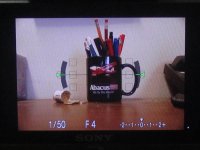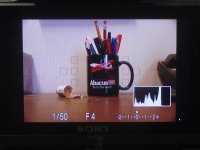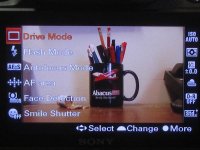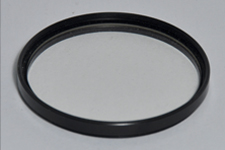Online Magazine
Recent Posts
- Safeguard your Cellphone Photos
- Black & White to Color – Instantly
- Wearing Many Hats
- Video Roundup
- Rescuing Your Blurry Pictures
- Showing Their Age
- What is Your Angle?
- Panorama Photos
- Humorous Photos
- Close Ups
- Fisheye Pictures
- Photo Antiquities
- Printing Big
- Appreciating Scale
- Celebrity Sightings
Tags
More Places to Go
- Free "How-To" Books “How To” books for popular cameras 0
- Vist Us on Facebook keep in touch with us on Facebook 2
Archives
- July 2023 (1)
- March 2023 (2)
- February 2023 (1)
- December 2022 (1)
- October 2022 (1)
- September 2022 (8)
- August 2022 (9)
- July 2022 (1)
- June 2022 (1)
- June 2021 (1)
- May 2021 (1)
- March 2021 (5)
- February 2021 (4)
- January 2021 (2)
- April 2019 (1)
- March 2019 (1)
- February 2019 (1)
- October 2018 (2)
- April 2018 (1)
- March 2018 (4)
- February 2018 (1)
- November 2017 (1)
- August 2017 (1)
- June 2017 (1)
- April 2017 (1)
- March 2017 (5)
- February 2017 (2)
- January 2017 (1)
- October 2016 (1)
- September 2016 (1)
- August 2016 (1)
- July 2016 (1)
- May 2016 (1)
- April 2016 (1)
- March 2016 (2)
- February 2016 (1)
- January 2016 (2)
- December 2015 (1)
- November 2015 (1)
- October 2015 (3)
- April 2015 (1)
- March 2015 (5)
- February 2015 (1)
- January 2015 (4)
- December 2014 (2)
- November 2014 (5)
- October 2014 (2)
- September 2014 (1)
- August 2014 (2)
- July 2014 (1)
- May 2014 (1)
- April 2014 (5)
- March 2014 (5)
- December 2013 (2)
- November 2013 (18)
- October 2013 (1)
- September 2013 (1)
- August 2013 (1)
- July 2013 (1)
- June 2013 (3)
- May 2013 (1)
- April 2013 (2)
- March 2013 (1)
- February 2013 (1)
- January 2013 (1)
- December 2012 (1)
- November 2012 (2)
- October 2012 (2)
- September 2012 (5)
- August 2012 (2)
- July 2012 (1)
- June 2012 (1)
- May 2012 (1)
- April 2012 (4)
- March 2012 (1)
- February 2012 (1)
- January 2012 (3)
- December 2011 (1)
- November 2011 (3)
- October 2011 (1)
- September 2011 (2)
- August 2011 (2)
- June 2011 (3)
- May 2011 (4)
- April 2011 (8)
- March 2011 (8)
- February 2011 (10)
- January 2011 (6)
- December 2010 (11)
- November 2010 (14)
- October 2010 (6)
- September 2010 (12)
- August 2010 (2)
- July 2010 (4)
- June 2010 (3)
- May 2010 (1)
- April 2010 (1)
- March 2010 (2)
- February 2010 (1)
- January 2010 (1)
- December 2009 (1)
- November 2009 (2)
- October 2009 (2)
- September 2009 (1)
- August 2009 (3)
- July 2009 (2)
- June 2009 (1)
- May 2009 (2)
- April 2009 (1)
- March 2009 (2)
- February 2009 (1)
- January 2009 (3)
Sony Alpha A55 – Review Part 2
14th March 2011
Unique Features of the Sony Alpha A55
The Sony Alpha A55 has a long list of features – some of which you may find in a few other cameras and others that are unique only to the A55. But taken together they they make the A55 a very compelling piece of equipment.
In Part 1, I talked about the “standard” features of the A55.
In this part of the review, I’ll key in on several of these features that are both unique and innovative.
The first three features are possible because of the A55’s translucent mirror.
Electronic Viewfinder
Protective Filters For Your Lens
14th March 2011
To protect it from scratches and help keep it clean, consider using a clear protective filter on your camera lens.
Now you might be thinking “isn’t that the purpose of a lens cap?” and you’d be correct. The problem with a lens cap, however, is that it’s so easy to lose or misplace it. A filter, unlike the lens cap, is actually attached to the lens so it cannot fall off or become lost. Also, you won’t lose an opportunity of snaping a once in a lifetime photo by fumbling with the camera to remove the lens cap.
Keep in mind as you consider using a filter that if you ask ten photographers whether they use filters, five may say yes and five may say never. In other words, there are many opinions on the value of protective filters. Some believe that a filter is unnecessary and therefore they rarely, if ever, use a protective filter. They may prefer using lens caps, lens hoods or simply handling their cameras very carefully.
Some photographers believe that lenses made today are already protected with special coatings against scratches and dust and, therefore, don’t need any protection from the environment in most normal photography conditions.
Other photographers keep a filter on each lens they use, perhaps taking the filter off during certain types of photography.
You’ll have to decide whether a quality clear filter is best for your shooting situations.
Note: instead of a clear filter, you may also consider an UV filter. It serves the same purpose as a clear protective filter but may be easier to find at your local camera dealer.
Written by Scott Slaughter
Sony Alpha A55 – Review Part 1
12th March 2011
A New Breed of Camera
I first laid my hands on the Sony Alpha A55 (and the smaller, less expensive Alpha 33) at the PhotoPlus Expo in New York City last September.
What interested me in this new camera was its fixed translucent mirror. In a conventional DSLR, the reflex mirror reflects the image into the viewfinder and then swings out of the way when you press the shutter to send the image to the “film” light sensor. In the Alpha 55, the translucent mirror sends a small portion of the incoming image to the viewfinder and the remainder to the “film” light sensor. This stationary mirror gives the camera several unique features that I’ll describe shortly. This technology isn’t new. In the early 1960′s Canon made a model called the Pellix using a similar scheme with a pellicle mirror. My uncle bought this camera back then, one of the first to have Through The Lens metering (TTL) and it served him well for many years.
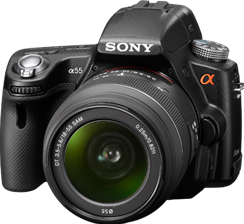 |
The A55’s translucent mirror eliminates the reflex mechanism providing a space, weight and cost savings. Removing this mechanical assembly also allows for a higher frame rate. Next, the electronics measuring the auto exposure remain uninterrupted from frame to frame giving instant responses to varying changes in lighting. Similarly, the auto focus system stays 100% available – a very important consideration for high speed continuous shooting. |
